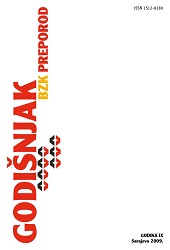Spomenici u Brčkom
Monuments in the Brčko
Author(s): Enes PašalićSubject(s): Cultural Essay, Political Essay, Societal Essay
Published by: Bošnjačka zajednica kulture "Preporod"
Keywords: Monuments; Brčko District – Bosnia and Herzegovina
Summary/Abstract: Disclosing the specific nature of the monument in the Brčko District and the District, the author begins by analyzing the order of the Supervisor for Brčko, which orders the construction of three military monuments and a memorial to civilian victims of war. Monument to civilian victims of war should be ethnically, politically, ethnically and religiously neutral and it symbolized not only the civilian victims of the 1992-1995 war, but the war 1939-1945. Abstraction of the specific (national, religious ...) definition of civilian victims of war, symbolically at the level of collective memory that is concealed in Brčko had happened “radical evil”, ethnical cleansing of non-Serb civilian population, with the aim of the alleged equality of constituent peoples. By sintagmatic-semiotic analysis of monuments in Brčko, as public characters (symbols), the author reveals their hidden meaning as a monument to the permanent civil war in which all three national armies, equally and without exception, committed war crimes against civilians. The judgement for Goran Jelišić, convicted in The Hague for war crimes committed in Brčko, shows that such meaning is historical forgery based on the “strategy of forgetfulness”. Goran Jelišić, as a member of the Serbian armed forces, committed in Brčko crime against humanity. Crime against humanity is the crime of radical violence or radical evil, which can not be forgotten and forgiven. Discussing with the apologists of crimes forgetfulness who treat it as a precondition for forgiveness and reconciliation, the author concludes that forgiveness and reconciliation is possible after establishing the crime and the perpetrators of the crime. As in Brčko (B&H) crimes such as denying (no sides in the conflict admit to committing crimes), hence there is expiation or repentance, and then consequently neither forgiveness nor reconciliation. Finally, the author concludes that forgetting leads to amnesty for crimes and that amnesty for crimes leads to new crimes. Without the truth of what happened 1992-1995 there has been no true coexistence. This should be the true nature of the monument in Brčko, as well as Brčko District (B&H).
Journal: Godišnjak Bošnjačke zajednice kulture »Preporod«
- Issue Year: 2009
- Issue No: 1
- Page Range: 54-72
- Page Count: 19
- Language: Bosnian

